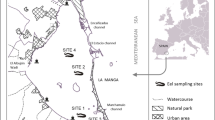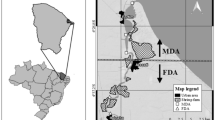Abstract
In order to examine the ecological risk for organic pollutants in diadromous fish migrating between sea and freshwater, organochlorine compounds (OCs) were determined in the catadromous eel Anguilla japonica having marine, estuarine and freshwater residence life histories. The eels were collected in Japanese coastal areas. We also compared the OCs accumulation with the marine eel Conger myriaster, which has a similar life history as A. japonica in the marine environment. The ontogenic changes in the otolith strontium (Sr) and calcium (Ca) concentrations were examined along the life history transect to discriminate the migration type. There were generally three different patterns, which were categorized as ‘marine residence’ (spent most of their life in the sea and did not enter freshwater), ‘estuarine residence’ (inhabited estuaries or switched between different habitats), and ‘freshwater residence’ (entered and remained in freshwater river habitats after arrival in the estuary) according to the otolith Sr:Ca ratio. There were generally no correlations between OCs such as Dichlorodiphenyltrichloroethanes (DDTs), Hexachlorobenzene (HCB), Hexachlorocyclohexanes (HCHs) and Chlordanes (CHLs) accumulation and each biological characteristic such as TL, BW and age in A. japonica. A positive correlation between the lipid content and concentrations of OCs were found. Additionally, the concentrations of HCB, ∑HCHs, ∑CHLs and ∑DDTs in A. japonica were significantly higher than those of C. myriaster, associating with the higher lipid contents (14% on average) in the former than the latter eels (9% on average). A negative linear relationship was found between the otolith Sr:Ca ratios and concentration of each OCs in A. japonica. The ecological risk of OCs increase as the freshwater residence period in the eel becomes longer. It is clear that migratory histories and lipid contents directly affected OCs accumulation in the anguillid eels.





Similar content being viewed by others
References
Albaigfs J, Farran A, Soler M, Gallifa A (1987) Accumulation and distribution of biogenic and pollutant hydrocarbons, PCBs and DDTs in tissues of western Mediterranean fish. Mar Environ Res 22:1–18
Arai T, Otake T, Tsukamoto K (1997) Drastic changes in otolith microstructure and microchemistry accompanying the onset of metamorphosis in the Japanese eel Anguilla japonica. Mar Ecol Prog Ser 161:17–22
Arai T, Kotake A, Lokman PM, Miller MJ, Tsukamoto K (2004) Evidence of different habitat use by New Zealand freshwater eels Anguilla australis and A. dieffenbachii, as revealed by otolith microchemistry. Mar Ecol Prog Ser 266:213–225
Arai T, Kotake A, McCarthy TK (2006) Habitat use by the European eel Anguilla anguilla in Irish waters. Estuar Coast Shelf Sci 67:569–578
Bidleman TF, Wall MD, Roura R, Carr E, Schmidt S (1993) Organochlorine pesticides in the atmosphere of the Southern Ocean and Antarctica, January–March, 1990. Mar Pollut Bull 26:258–262
Boetius I, Boetius J (1980) Experimental maturation of female silver eels, Anguilla Anguilla estimated of fecundity and energy reserves for migration and spawning. Dana 1:1–28
Chino N, Arai T (2009) Relative contribution of migratory type on the reproduction of migrating silver eels, Anguilla japonica, collected off Shikoku Island, Japan. Mar Biol 156:661–668
Chino N, Arai T (2010a) Migratory history of the giant mottled eel Anguilla marmorata in the Bonin Islands of Japan. Ecol Freshw Fish 19:19–25
Chino N, Arai T (2010b) Occurrence of marine resident tropical eel Anguilla bicolor bicolor in Indonesia. Mar Biol 157:1075–1081
Chino N, Arai T (2010c) Habitat use and habitat transitions in the tropical eel, Anguilla bicolor bicolor. Environ Biol Fish 89:571–578
Chiuchiolo AL, Dickhut RM, Cochran MA, Ducklow HW (2004) Pesticides organic pollutants at the base of the Antarctic marine food web. Environ Sci Technol 38:3551–3557
Colborn T, Smolen MJ (1996) Epidemiological analysis of persistent organochlorine contaminants in cetaceans. Rev Environ Contam Toxicol 146:91–172
Corsi I, Mariottini M, Badesso A, Caruso T, Borghesi N, Bonacci S, Iacocca A, Focardi S (2005) Contamination and sub-lethal toxicological effects of persistent organic pollutants in the European eel (Anguilla anguilla) in the Orbetello lagoon (Tuscany, Italy). Hydrobiologia 550:237–249
De Boer J, Dao QT, van Leeuwen SPJ, Kotterman MJJ, Schobben JHM (2010) Thirty year monitoring of PCBs, organochlorine pesticides and tetrabromodiphenylether in eel from The Netherlands. Environ Pollut 158:1228–1236
de Brito APX, Ueno D, Takahashi S, Tanabe S (2002) Organochlorine and butyltin residues in walleye Pollock (Theragra chalcogramma) from Bering Sea, Gulf of Alaska and Japan Sea. Chemosphere 46:401–411
De Silva SS, Gunasekera RM, Collins RO (2002) Some morphometric and biochemical features of ready-to-migrate silver and pre-migratory yellow stages of the shortfin eel of south-eastern Australian waters. J Fish Biol 61:915–928
Ewald GP, Larsson H, Linge L, Okla L, Szarzi N (1998) Biotransport of organic pollutants to an inland Alaska lake by migrating sockeye salmon (Onchorhynchus nerka). Arctic 51:40–47
Ferrante MC, Clausi MT, Meli R, Fusco G, Naccari C, Lucisano A (2010) Polychlorinated biphenyls and organochlorine pesticides in European eel (Anguilla anguilla) from the Garigliano River (Campania region, Italy). Chemosphere 78:709–716
Fisk AT, Tittlemier SA, Pranschke JL, Norstrom RJ (2002) Using anthropogenic contaminants and stable isotopes to assess the feeding ecology of Greenland shark. Ecology 83:2162–2172
Fu S, Chu S, Xu X (2001) Organochlorine pesticide residue in soils from Tibet, China. Bull Environ Contam Toxicol 66:171–177
Hamilton MC, Hites RA, Schwager SJ, Foran JA, Knuth BA, Carpenter DO (2005) Lipid composition and contaminations in farmed and wild salmon. Environ Sci Technol 39:8622–8629
Iwata H, Tanabe S, Sakai N, Tatsukawa R (1993) Distribution of persistent organochlorines in the oceanic air and surface seawater and the role of ocean on their global transport and fate. Environ Sci Technol 27:1080–1098
Knights B (1997) Risk assessment and management of contamination of eels (Anguilla spp.) by persistent xenobiotic organochlorine compounds. Chem Ecol 13:171–212
Krümmel EM, MacDonald RW, Kimpe LE, Gregory-Eaves I, Demers MJ, Smol JP, Finney B, Blais JM (2003) Delivery of pollutants by spawning salmon. Nature 425:255–256
Larsson P, Hamrin S, Okla L (1991) Factors determining the uptake of persistent pollutants in a eel population (Anguilla anguilla L.). Environ Pollut 69:39–50
Lokman PM, Vermeulen G, Lambert JGD, Young G (1998) Gonad histology and plasma steroid profiles in wild New Zealand freshwater eels (Anguilla dieffenbachii and A. australis) before and at the onset of the natural spawning migration. I. Females. Fish Physiol Biochem 19:325–338
Lum KR, Kaiser KLE, Comba ME (1987) Export of mirex from Lake Ontario to the St. Lawrence estuary. Sci Total Environ 67:41–51
Maes J, Goemans G, Belpaire C (2008) Spatial variation and temporal pollution profiles of polychlorinated biphenyls, organochlorine pesticides and heavy metals in European yellow eel (Anguilla anguilla L.) (Flanders, Belgium). Environ Pollut 153:223–237
Matsui I (1972) Eel biology-biological study. Koseisha-Koseikaku, Tokyo
McHugh B, Poole R, Corcoran J, Anninou P, Boyle B, Joyce E, Foley MB, McGovern E (2010) The occurrence of persistent chlorinated and brominated organic contaminants in the European eel (Anguilla anguilla) in Irish waters. Chemosphere 79:305–313
Merna JW (1986) Contamination of stream fishes with chlorinated hydrocarbons from eggs to Great Lakes salmon. Trans Am Fish Soc 115:69–74
Monirith I, Nakata H, Tanabe S, Tana TS (1999) Persistent organochlorine residues in marine and freshwater fish in Cambodia. Mar Pollut Bull 38:604–612
Naiman RJ, Bilby RE, Schindler DE, Helfield JM (2002) Pacific salmon, nutrients, and the dynamics of freshwater and riparian ecosystems. Ecosystems 5:399–417
Naismith IA, Knights B (1990) Modelling of unexploited and exploited populations of Anguilla anguilla (L.), in the Thames Estuary. J Fish Biol 37:975–986
Niimi AJ, Oliver BG (1983) Biological half-lives of plychlorinated biphenyls (PCB) congeners in whole fish and muscle of rainbow trout (Salmo gardner). Can J Fish Aquat Sci 40:1388–1394
Pastor D, Boix J, Fernandez V, Albaiges J (1996) Bioaccumulation of organochlorinated contaminants in three estuarine fish species (Mullus barbatus, Mugil cephalus and Dicentrarcus labrax). Mar Pollut Bull 32:257–262
Pizza JC, O’Connor JM (1983) PCB dynamics in Hudson River striped bass. II Accumulation from dietary sources. Aquat Toxicol 3:313–327
Rossel D, Honsberger P, Tarradellas J (1987) Bioaccumulative behaviour of some PCB congeners in lake Geneva Brown Trout (Salmo trutta laccustris L.). Int J Environ Anal Chem 31:219–233
Scrudato RJ, McDowell WH (1989) Upstream transport of mirex by migrating salmonids. Can J Fish Aquat Sci 46:1484–1488
Sokal RR, Rohlf FJ (1995) Biometry. The principles and practice of statistics in biological research, 3rd edn. WH Freeman and Company, New York
Spigarelli SA, Thommes MM, Prepejchal W (1983) Thermal and metabolic factors affecting PCB uptake by adult brown trout. Environ Sci Technol 17:88–94
Szlinder-Richert J, Usydus Z, Pelczarski W (2010) Organochlorine pollutants in European eel (Anguilla anguilla L.) from Poland. Chemosphere 80:93–99
Takai T (1959) Studies on the morphology, ecology and culture of the important apodal fishes, Muraenesox cinereus (Forsskal) and Conger myriaster (Brevoort). J Shimonoseki Coll Fish 8:209–555
Tesch FW (1977) The eel. Biology and management of anguillid eels. Chapman & Hall, London
Tulonen J, Vuorinen PJ (1996) Concentrations of PCBs and other organochlorine compounds in eels (Anguilla anguilla L.) of the Vanajavesi watercourse in southern Finland, 1990–1993. Sci Total Environ 187:11–18
Utoh T, Mikawa N, Okamura A, Yamada Y, Tanaka S, Horie N, Akazawa A, Oka HP (2004) Ovarian morphology of the Japanese eel in Mikawa Bay. J Fish Biol 64:502–513
Van der Oost R, Opperhuizen A, Satumalay K, Heida H, Vermeulen NPE (1996) Biomonitoring aquatic pollution with feral eel (Anguilla anguilla). 1. Bioaccumulation: biota-sediment ratios of PCBs, OCPs, PCDDs and PCDFs. Aquat Toxicol 35:21–46
Wania F, Mackay D (1996) Tracking the distribution of persistent organic pollutants. Environ Sci Technol 30:390–396
Acknowledgment
This work was supported in part by Grant-in-Aid No. 20688008 from the Ministry of Education, Culture, Sports, Science, and Technology of Japan.
Author information
Authors and Affiliations
Corresponding author
Rights and permissions
About this article
Cite this article
Arai, T., Takeda, A. Differences in organochlorine accumulation accompanying life history in the catadromous eel Anguilla japonica and the marine eel Conger myriaster . Ecotoxicology 21, 1260–1271 (2012). https://doi.org/10.1007/s10646-012-0881-8
Accepted:
Published:
Issue Date:
DOI: https://doi.org/10.1007/s10646-012-0881-8




